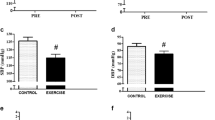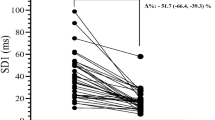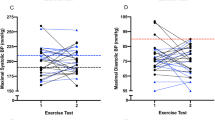Abstract
Post-exercise hypotension (PEH) is a clinically relevant phenomenon, but its mechanisms vary between different studies and between the participants within each study. Additionally, it is possible that PEH mechanisms are not consistent in each individual (i.e. within-individual variation), which has not been investigated yet. Thus, the aim of the current study was to assess the within-individual consistency of PEH hemodynamic and autonomic mechanisms. For that, 30 subjects performed 4 sessions divided in 2 blocks (test and retest). In each block, an exercise (cycling, 45 min, 50%VO2peak) and a control (seated rest, 45 min) session was randomly conducted. Blood pressure (BP) and its mechanisms were evaluated pre- and post-interventions. In each block, individual responses were calculated as post-exercise minus post-control, and a response was considered present when its magnitude reached the typical error of the measurement. Consistencies were evaluated by comparing test and retest responses through kappa coefficient (k). PEH consistency was calculated using role sample, while mechanisms consistency was evaluated in those with consistent PEH. Twenty-one (70%) participants showed consistent PEH, 5 (17%) presented PEH in only test or retest and 4 (13%) had absent PEH response, characterising a good consistency (k = 0.510). Regarding mechanisms’ responses, good consistency was found for heart rate (k = 0.456), sympathovagal balance (k = 0.438), and baroreflex sensitivity (k = 0.458); while systemic vascular resistance (k = 0.152), cardiac output (k = −0.400), stroke volume (k = −0.055), and sympathetic vasomotor modulation (k = −0.096) presented marginal consistencies. Thus, PEH is a highly consistent physiological phenomenon, although its mechanisms present variable consistencies.
This is a preview of subscription content, access via your institution
Access options
Subscribe to this journal
Receive 12 digital issues and online access to articles
$119.00 per year
only $9.92 per issue
Buy this article
- Purchase on Springer Link
- Instant access to full article PDF
Prices may be subject to local taxes which are calculated during checkout


Similar content being viewed by others
References
Kenney MJ, Seals DR. Postexercise hypotension. Key features, mechanisms, and clinical significance. Hypertension. 1993;22:653–64.
Pescatello LS, Franklin BA, Fagard R, Farquhar WB, Kelley GA, Ray CA. Exercise and hypertension. Med Sci Sport Exerc. 2004;36:533–53.
Luttrell MJ, Halliwill JR. Recovery from exercise: vulnerable state, window of opportunity, or crystal ball? Front Physiol. 2015;6:204.
Brito LC, Fecchio RY, Peçanha T, Andrade-Lima A, Halliwill JR, Forjaz CLM. Postexercise hypotension as a clinical tool: a “single brick” in the wall. J Am Soc Hypertens. 2018;12:e59–64.
Cucato GG, Chehuen M, da R, Ritti-Dias RM, Carvalho CRF, Wolosker N, et al. Post-walking exercise hypotension in patients with intermittent claudication. Med Sci Sports Exerc. 2015;47:460–7.
Halliwill JR, Taylor JA, Eckberg DL. Impaired sympathetic vascular regulation in humans after acute dynamic exercise. J Physiol. 1996;495:279–88.
Cléroux J, Kouamé N, Nadeau A, Coulombe D, Lacourcière Y. Aftereffects of exercise on regional and systemic hemodynamics in hypertension. Hypertension. 1992;19:183–91.
Jones H, George K, Edwards B, Atkinson G. Is the magnitude of acute post-exercise hypotension mediated by exercise intensity or total work done? Eur J Appl Physiol. 2007;102:33–40.
Harvey PJ, Morris BL, Kubo T, Picton PE, Su WS, Notarius CF, et al. Hemodynamic after-effects of acute dynamic exercise in sedentary normotensive postmenopausal women. J Hypertens. 2005;23:285–92.
Bisquolo VAF, Cardoso CG, Ortega KC, Gusmão JL, Tinucci T, Negrão CE, et al. Previous exercise attenuates muscle sympathetic activity and increases blood flow during acute euglycemic hyperinsulinemia. J Appl Physiol. 2005;98:866–71.
Halliwill JR, Buck TM, Lacewell AN, Romero SA. Postexercise hypotension and sustained postexercise vasodilatation: what happens after we exercise? Exp Physiol. 2013;981:7–18.
Romero SA, Minson CT, Halliwill JR. The cardiovascular system after exercise. J Appl Physiol. 2017;122:925–32.
Dujić Ž, Ivančev V, Valic Z, Baković D, Marinović-Terzić I, Eterović D, et al. Postexercise hypotension in moderately trained athletes after maximal exercise. Med Sci Sports Exerc. 2006;38:318–22.
Hamer M, Boutcher SH. Impact of moderate overweight and body composition on postexercise hemodynamic responses in healthy men. J Hum Hypertens. 2006;20:612–7.
de Brito L, Rezende RA, Da Silva ND, Tinucci T, Casarini DE, Cipolla-Neto J, et al. Post-exercise hypotension and its mechanisms differ after morning and evening exercise: A randomized crossover study. PLoS One. 2015;10:e0132458.
Brito LC, Queiroz ACC, Forjaz CLM. Influence of population and exercise protocol characteristics on hemodynamic determinants of post-aerobic exercise hypotension. Braz J Med Biol Res. 2014;47:626–36.
Forjaz C, Cardoso C, Rezk C, Santaella D, Tinucci T. Postexercise hypotension and hemodynamics: the role of exercise intensity. J Sports Med Phys Fit. 2004;44:54–62.
Fecchio RY, Chehuen M, Brito LC, Peçanha T, Queiroz ACC, de Moraes Forjaz CL. Reproducibility (reliability and agreement) of post-exercise hypotension. Int J Sports Med. 2017;38:1029–34.
Fecchio RY, Brito LC, de, Peçanha T, Forjaz CL, de M. Post-exercise hypotension and its hemodynamic determinants depend on the calculation approach. J Hum Hypertens. 2020;34:719–26.
Jones N, Campbell E, McHardy G, Higgs B, Clode M. The estimation of carbon dioxide pressure of mixed venous blood during exercise. Clin Sci. 1967;32:311–27.
European Society of Cardiology; North American Society of Pacing and Electrophysiology. Heart rate variability. Standards of measurement, physiological interpretation, and clinical use. Task Force of the European Society of Cardiology and the North American Society of Pacing and Electrophysiology. Eur Heart J. 1996;17:354–81.
Hopkins WG. Measures of reliability in sports medicine and science. Sport Med. 2000;30:1–15.
Williamson JW. The relevance of central command for the neural cardiovascular control of exercise. Exp Physiol. 2010;95:1043–8.
Swinton PA, Hemingway BS, Saunders B, Gualano B, Dolan E. A statistical framework to interpret individual response to intervention: paving the way for personalised nutrition and exercise prescription. Front Nutr. 2018;5:41.
Rosner B. Fundamentals of Biostatistics. 7th edn. (Boston: Brooks/Cole, Cengage Learning; 2011).
Costa EC, Dantas TCB, Junior LF, de F, Frazão DT, Prestes J, et al. Inter- and Intra-Individual Analysis of Post-Exercise Hypotension Following a Single Bout of High-Intensity Interval Exercise and Continuous Exercise: A Pilot Study. Int J Sports Med. 2016;37:1038–43.
Lockwood JM, Wilkins BW, Halliwill JR. H1 receptor-mediated vasodilatation contributes to postexercise hypotension. J Physiol. 2005;563:633–42.
De Brito LC, Fecchio RY, Peçanha T, Lima A, Halliwill J, Forjaz CLDM. Recommendations in post-exercise hypotension: concerns, best practices and interpretation. Int J Sports Med. 2019;40:487–97.
Liu X, Iwanaga K, Shimomura Y, Katsuura T. The reproducibility of cardiovascular response to a mental task. J Physiol Anthropol. 2010;29:35–41.
Fonkoue IT, Carter JR. Sympathetic neural reactivity to mental stress in humans: test-retest reproducibility. Am J Physiol Regul Integr Comp Physiol. 2015;309:R1380–6.
Pappano AJ, Wier WG. Cardiovascular Physiology, 10th edn. Philadelphia: Elsevier; 2012.
Rondon M, Alves M, Braga A, Teixeira O, Barretto A, Krieger E, et al. Postexercise blood pressure reduction in elderly hypertensive patients. J Am Coll Cardiol. 2002;39:676–82.
Youde J, Panerai R, Gillies C, Potter J. Reproducibility of circulatory changes to head-up tilt in healthy elderly subjects. Age Ageing. 2003;32:375–81.
Beevers G, Lip GY, O’Brien E. The pathophysiology of hypertension. BMJ 2001;322:912–6.
Lobo FS, Queiroz AC, Silva Junior ND, Medina FL, Costa LA, Tinucci T, et al. Hydration does not change postexercise hypotension and its mechanisms. J Phys Act Heal. 2020;17:533–9.
Brito LC, Azevêdo L, Peçanha T, Fecchio RY, Rezende RA, da Silva GV, et al. Effects of ACEi and ARB on post-exercise hypotension induced by exercises conducted at different times of day in hypertensive men. Clin Exp Hypertens. 2020;42:722–7.
Ramirez-Jimenez M, Morales-Palomo F, Ortega JF, Mora-Rodriguez R. Post-exercise hypotension produced by supramaximal interval exercise is potentiated by angiotensin receptor blockers. Int J Sports Med. 2019;40:756–61.
Acknowledgements
The authors want to acknowledge the volunteers of the current study.
Funding
This study was supported by Coordenação de Aperfeiçoamento de Pessoal de Nível Superior – Brasil (CAPES/PROEX, code 001) and the Brazilian National Council for Scientific and Technological Development (CNPQ, process 304436/2018-6.).
Author information
Authors and Affiliations
Corresponding author
Ethics declarations
Conflict of interest
The authors declare that they have no conflict of interest.
Consent to participate
All participants provided informed consent before beginning their participation in the study.
Ethics approval
The current data was conducted in accordance with the principles of the Declaration of Helsinki. This study is a part of a bigger study that was approved by the local Ethics Committee (no 2015/06) and included at Brazilian Clinical Trials register (www.ensaiosclinicos.gov.bR-RBR-3nxn34).
Additional information
Publisher’s note Springer Nature remains neutral with regard to jurisdictional claims in published maps and institutional affiliations.
Rights and permissions
About this article
Cite this article
Fecchio, R.Y., Brito, L.C., Peçanha, T. et al. Consistency of hemodynamic and autonomic mechanisms underlying post-exercise hypotension. J Hum Hypertens 35, 1003–1011 (2021). https://doi.org/10.1038/s41371-020-00452-w
Received:
Accepted:
Published:
Issue Date:
DOI: https://doi.org/10.1038/s41371-020-00452-w



